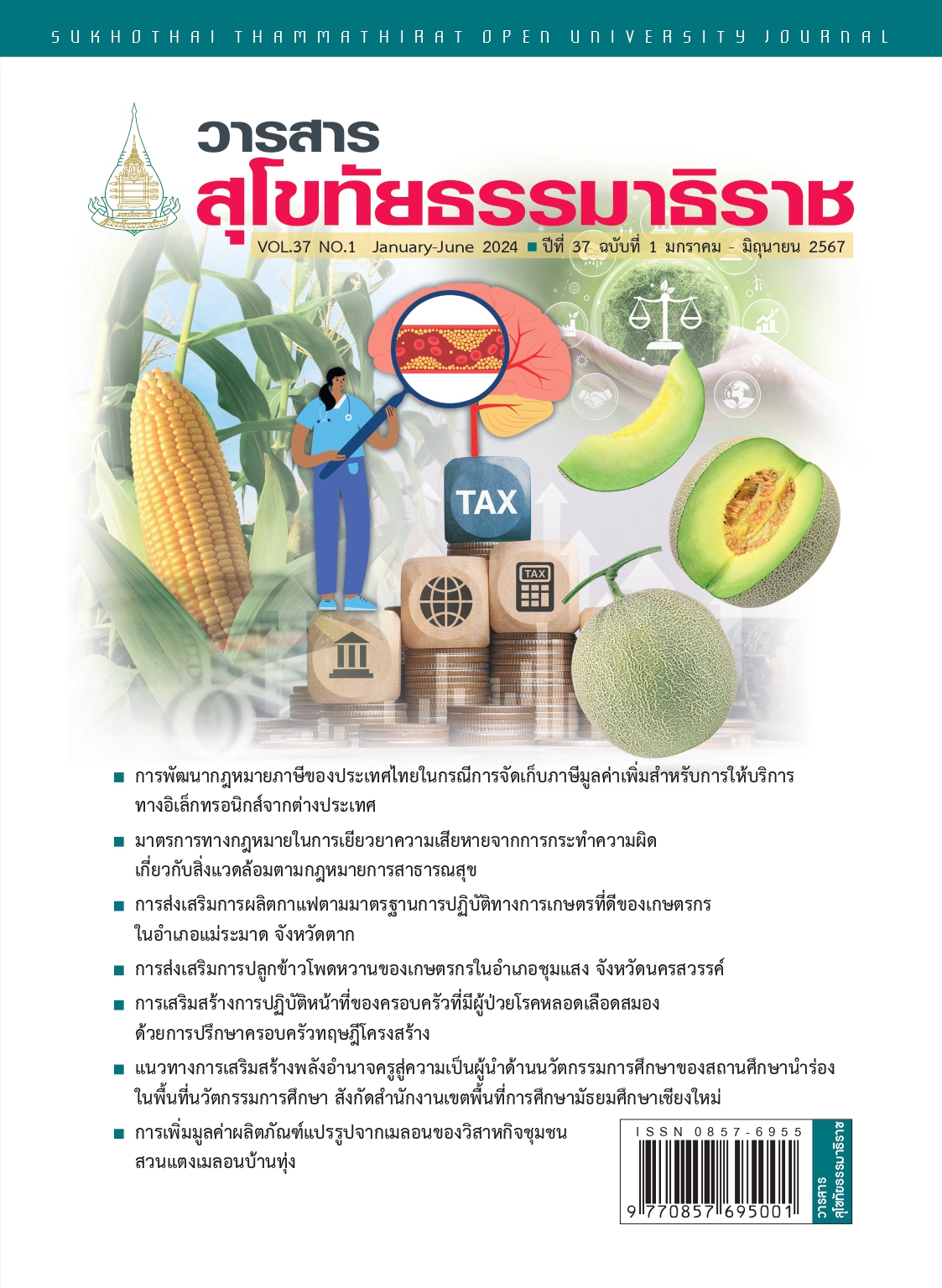Legal Measurement of Remedies from Environmental Offenses by the Public Health Law
Keywords:
Legal measures, Assisting the victim, Environment, Environmental crime, Public healthAbstract
This independent study aims to 1) study of concept, theory and principle about assisting the environmental crime victim 2) study legal measures about assisting the environmental crime victim in United States, Japan and Thailand 3) analyze and compare legal measures about assisting the environmental crime victim in United States, Japan and Thailand 4) suggest an appropriate guideline of measures to assisting the environmental crime victim according to the Public health law that proper for Thailand. The results revealed that 1) by applying concept about consideration of illness and assisting from poisoned with no symptoms and the Polluter pays principle are fundamentals for setting measures of assisting the environmental crime victim 2) United States and Japan have the legal about assisting the environmental crime to setting up the Healing fund but Thailand have the legal for criminal punishment and administrative measures to prevent the offense 3) although United states and Japan also have the Healing fund but with different objective, United States focus to healing environment but Japan focus to healing victim, while Thailand have no healing measures 4) Thai Public health law should revise to have provision of The Healing fund to assisting victim by paying compensation from environmental crime according to the Public health law, victim will be considered right and compensation paid from the Healing fund without bringing the case to court: as a result, victim will be healed in time.
References
Armeen, S. (2013). Environmental Litigation in the Judiciary. Training Manual for Environmental Lawyers, 5th Edition.
Bureau of Environmental Health, Department of Health, Ministry of Public Health. (2017). Guide to Community Environmental Health Management for the Public. Bangkok: Mahachulalongkornrajavidyalaya University Press.
Chaianong, L. (2007). Environmental Case Adjudication: Experiences from Japanese Courts. Yutithamparitat Journal, 1(5).
EPA United States Environmental Protection Agency. from Summary of the Comprehensive Environmental Response, Compensation, and Liability Act (Superfund) | US EPA.
Ferrara v. Galluchio (5 NY2d 16, 152 N.E.2d 249, 176 N.Y.S.2d 996 [1958]) from https://www.leagle.com/decision/1958215ny2d16120
Irving J. Sloan. (1971). Environment and the Law.
Katikan, K. (1990). Measures for Claiming Damages in Environmental Cases. Teaching Materials for Environmental Law Course (Unit 14, p. 343). (5th ed.). Bangkok: Sukhothai Thammathirat Open University Press.
Klaisuban, P. (2007). Concepts, Theories, and Legal Principles Related to Environmental Cases. Administrative Court Journal.
Leenapesanan, P. (2007). Environmental Case Adjudication in Japan. Yutithamparitat Journal,1(6).
Maolanond, P. Teaching Materials for Environmental Law Course, Unit 1: The Role of Law in Controlling and Organizing the Environment. Retrieved September 14, 2020, from https://dl.parliament.go.th/handle/lirt/460685
Mullikamal, S. (1989). Compensation for Damage from Industrial Pollution. Law Journal, 13(1).
Mullikamal, S. (1997). Product Liability Law in Japan. Bot Bundit Journal.
Mullikamal, S. (1999). Environmental Law Enforcement. Bangkok: Nititham.
Nimmanahaeminda, K. (1992). Environmental Law. Bangkok: Faculty of Law, Chulalongkorn University.
Phara, S. (2007). Natural Resources and Environment. Bangkok: Exper Net.
Phrompan, V. (2002). Recedure of Civil Environmental Case on the Public Resources by State Attorney. Master Thesis, LL.M., Ramkhamhaeng University.
Rayanakorn, K. (2006). Development of Environmental Law Principles and Community Rights. Academic Paper No. 25 (pp. 16-21). Public Participation Project in Drafting Natural Resources and Environmental Plans. Chiang Mai: Social Research Institute, Chiang Mai University
Ruangsri, W. (2009). Environmental Valuation: Experiences from the U.S. Courts. In Proceedings of the Academic Seminar on New Approaches to Developing Environmental Justice Processes. Rabi Badhanasakti Research and Development Institute, Off ice of the Judiciary.
Salyapong, J. (1982). Forms of Environmental Law. Master Thesis, LL.M, Chulalongkorn University.
Sinthipong, U. (2004). Environmental Law. Bangkok: Winuchon press.
Sotthibandhu, S. (2007). Commentary on Torts, Management of Affairs without Mandates and Undue Enrichment. Bangkok: Winyuchon Press.
Supanit, S. (1994). Commentary on Civil and Commercial Code: Tort Law. Bangkok: Sawang Sutthi Printing.
Thailand Population Statistics Report. Retrieved June 17, 2020, from https://www.worldometers. info/world-population/thailand-population/
Vannasaeng, P. (2012). The Role of the Court of Justice and Environmental Law. Retrieved October 2, 2020, from http://www.dlo.co.th/node/252
Wongbandit, A. (1986). Shifting the Burden of Proof to Address Def iciencies in Common Law in Toxic Environmental Cases in Canada. Thammasat Law Journal, 16(3), 166.
World Population Statistics Report. Retrieved June 17, 2020, from https://www.worldometers.info/world-population/#ref-1
Downloads
Published
Versions
- 2024-09-17 (2)
- 2024-09-17 (1)
How to Cite
Issue
Section
License
Copyright (c) 2024 Sukhothai Thammathirat Open University

This work is licensed under a Creative Commons Attribution-NonCommercial-NoDerivatives 4.0 International License.
บทความที่ได้รับการตีพิมพ์เป็นลิขสิทธิ์ของวารสารมหาวิทยาลัยสุโขทัยธรรมาธิราช
ข้อความที่ปรากฏในบทความแต่ละเรื่องในวารสารวิชาการเล่มนี้เป็นความคิดเห็นส่วนตัวของผู้เขียนแต่ละท่านไม่เกี่ยวข้องกับมหาวิทยาลัยสุโขทัยธรรมาธิราช และคณาจารย์ท่านอื่นๆในมหาวิทยาลัยฯ แต่อย่างใด ความรับผิดชอบองค์ประกอบทั้งหมดของบทความแต่ละเรื่องเป็นของผู้เขียนแต่ละท่าน หากมีความผิดพลาดใดๆ ผู้เขียนแต่ละท่านจะรับผิดชอบบทความของตนเองแต่ผู้เดียว
ห้ามนำข้อความทั้งหมด หรือบางส่วนไปพิมพ์ซ้ำ เว้นแต่จะได้รับอนุญาตจากกองบรรณาธิการวารสาร


